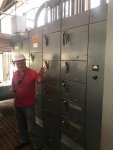- Location
- San Francisco Bay Area, CA, USA
- Occupation
- Electrical Engineer
I have to replace an ancient MCC in a Class II Division 1 environment (sugar mill). The old one was grandfathered in because I don't think sugar was considered explosive at the time this was built-out in the 60s, so it is not NEMA 9 or anything, plain old NEMA type 1 enclosures, not even gasketed! The buckets are full of sugar dust. My customer said he is getting a bid from someone telling him that they can put an MCC in a Class II area. I don't believe it, I think some noob is mixing up the concepts, as in NEMA Class II MCC, meaning inter-wiring between buckets, and UL Class II Division 1 explosive dust environment. But here in California we rarely come across grain elevators or mills where this is an issue, so I thought I'd throw it out there to some of you in more "grainy" areas of the country. Anyone ever heard of an MCC mfr willing to somehow build one that would pass NEMA 9? Or is there some "trick of the trade" I am unfamiliar with, such as purging the structure?
My fall back position is to tell him it can't be done, that he either has to have us pipe in a bunch of separate NEMA 9 enclosed starters, or move the entire MCC to a non-classified environment, neither of which is likely to get funded.
My fall back position is to tell him it can't be done, that he either has to have us pipe in a bunch of separate NEMA 9 enclosed starters, or move the entire MCC to a non-classified environment, neither of which is likely to get funded.

